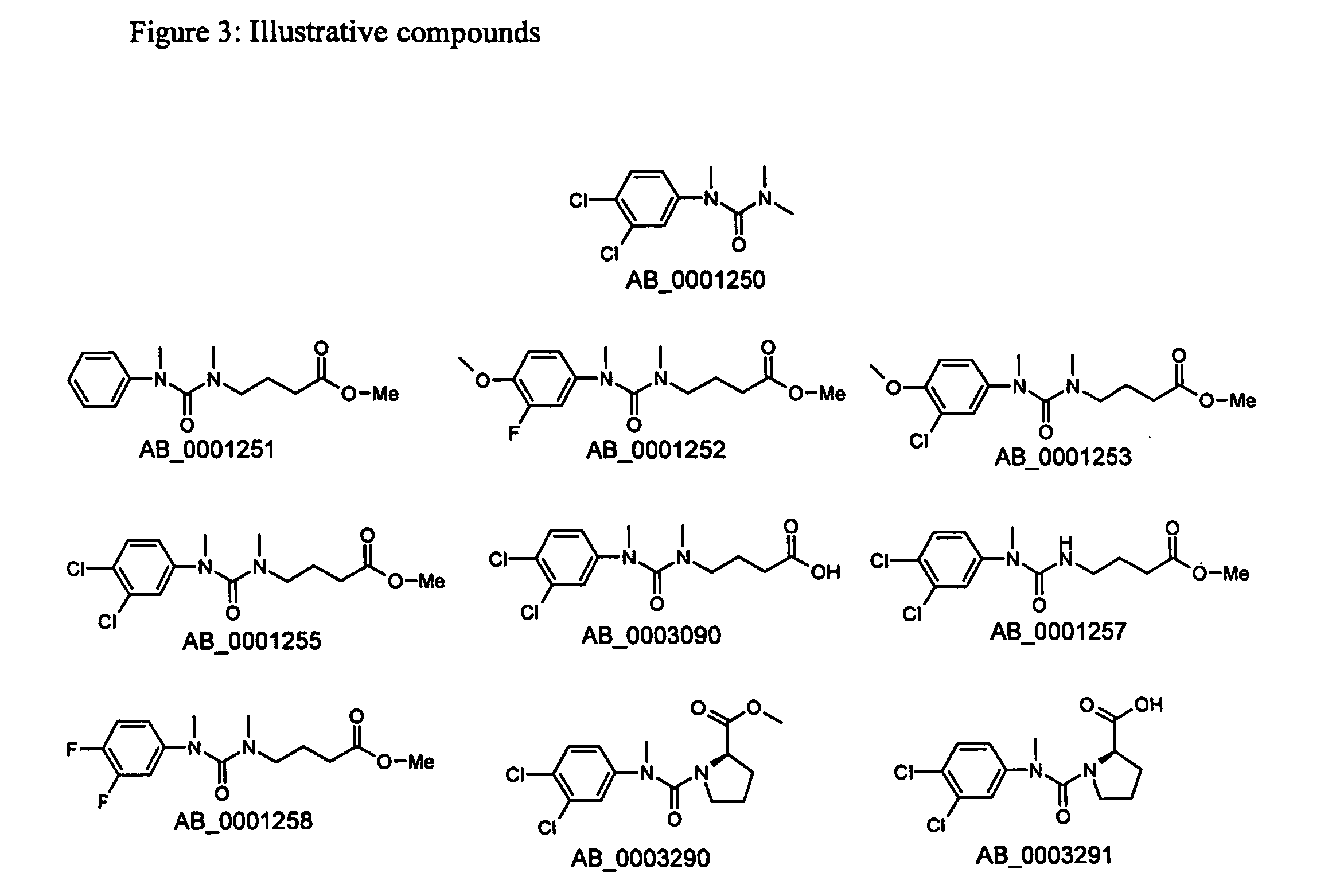Use of urea variants as affinity ligands
- Summary
- Abstract
- Description
- Claims
- Application Information
AI Technical Summary
Benefits of technology
Problems solved by technology
Method used
Image
Examples
example 1
Binding Test Using NMR
[0097] All NMR experiments were performed at 298 K on a Bruker Avance 500 MHz spectrometer. The 1D saturation transfer difference method (STD-NMR) was used as screening assay (Mayer M. and Meyer B. 1999. Characterisation of Ligand Binding by Saturation Transfer Difference NMR Spectroscopy. Angew. Chem., Int. Ed. 38: 1784-1788). The resulting STD-NMR spectrum shows the difference between spectra recorded with on- and off-resonance irradiation of the protein, respectively. The two spectra are recorded in the same experiment in an interleaved fashion. If the resulting STD-NMR spectrum shows the same signals as the reference 1H-NMR spectrum of the ligand the result is regarded as positive i.e. the ligand must have contacted the protein. Ligands that do not have any contact with the protein or are very tightly bound to the protein will not give any signal in the resulting STD-NMR spectrum. It has been shown that the method is capable of detecting ligands with disso...
example 2
Directed Library
Actions Undertaken after the Analysis of the NMR Screening
[0103] From the analysis of the results, two directed libraries centred on the structures of the confirmed strongest binder AB—0001250 were created.
Directed Library Centred on the Structure of AB—0001250
[0104] Hit AB—0001250 was one of the hits designated as strong binders. Also, the structure as such offered a potentially attractive synthetic route for varying the substitution pattern of central motif, i.e. the tetra substituted urea, including the introduction of a handle for immobilisation, e.g. to a gel. Therefore, AB—0001250 was chosen as a starting point in the continued development of improvements.
[0105] The analysis started with a search for varying the substitution pattern of the aromatic ring. The di-chloro substituted aromatic ring that is present in AB—0001250 does according to the docking fill the available space in an appropriate way in two dimensions but, since that structure is planar, a...
example 3
Molecular Modelling and Docking of Directed Library
[0108] The modelling and docking was performed as described above under Materials and Methods. The results from the docking are as follows:
[0109] All docked compounds in the directed library with the exception of AB—0001256 resulted in a docked conformation inside the binding pocket, which very closely resembles the position of the docked hit AB—0001250, see FIG. 4. In four of the compounds, this is the best-ranked solution. In one of them (AB—0001252), the solution corresponding to the molecule inside the pocket is the second ranked solution. AB—0001256 lacks one of the methyl groups in the tetra substituted urea moiety. Consequently the corresponding amide bond should be more constrained to a planar geometry as compared to the remaining compounds in the library for which such geometry is forbidden because of steric effects between the methyl groups. Apparently, the non-planar geometry is of importance for docking.
[0110] The val...
PUM
| Property | Measurement | Unit |
|---|---|---|
| Molar density | aaaaa | aaaaa |
| Molar density | aaaaa | aaaaa |
| Structure | aaaaa | aaaaa |
Abstract
Description
Claims
Application Information
 Login to View More
Login to View More - R&D
- Intellectual Property
- Life Sciences
- Materials
- Tech Scout
- Unparalleled Data Quality
- Higher Quality Content
- 60% Fewer Hallucinations
Browse by: Latest US Patents, China's latest patents, Technical Efficacy Thesaurus, Application Domain, Technology Topic, Popular Technical Reports.
© 2025 PatSnap. All rights reserved.Legal|Privacy policy|Modern Slavery Act Transparency Statement|Sitemap|About US| Contact US: help@patsnap.com



